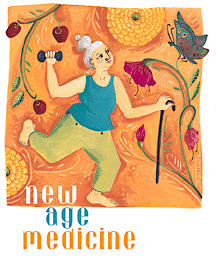

Reaching out to seniors like Herr is only possible through cooperation. "We can't do it alone," is a chorus repeated again and again by center researchers, who have all come to value the knowledge and expertise that each partner offers.
"This has been a perfect match," agrees Matthew Doherty, manager of senior and disability services at King County Housing Authority.
Doherty notes that programs like Cress' let his residents exercise even though they may not have the means to pay for recreation or the ability to visit senior centers. Proven results from these studies have helped community partners secure funding to keep the programs alive after research has ended.
"These partnerships become more and more critical," Buchner stresses. "Linking with community resources, health care providers and individuals provides the strength we need."
Encouraging words, a fitness partner or a regular exercise schedule can mean the difference between action and inaction for many seniors.
Getting out of the house can be difficult some days for Hal and Elizabeth Keene, who both suffer from osteoarthritis. Yet there's one excursion the pair won't miss--a drive to the Shoreline Community Swimming Pool for water aerobics.
"This program forces us to get out and exercise--something we never would have done without it," explains Elizabeth, her husband nodding in agreement.
For the past six months, three days a week, the couple have participated in the low-impact program developed by the National Arthritis Foundation. A research study through the UW center is testing the effectiveness of this program as a low-cost means for preventive care. Participants in cities throughout the state are contributing to the project.

In the warm, shallow waters of the Shoreline pool, energetic instructor Lisa Wilson leads the Keenes and six other seniors through underwater leg lifts, bounces and arm strokes at a near-continuous pace.
"Higher, higher, there you go!" she calls with success as the legs of two participants finally crest the water. "Let's do three more!"
The Keenes are impressed with the results, which they say began to appear after the first week's class. So impressed, in fact, that they wrote to Hal's sister in Kennewick to urge she get involved.
"She called to sign up right away," Hal says. "It will be good for her."
"It's hard when you find yourself feeling like you're 100 years old," Hal relates. "It's the little things, things like getting in and out of a car, that you realize are important to be able to do."
Perhaps the toughest challenge of preventive research is ensuring its lasting success. In addition to building muscle, building relationships has surfaced as a primary motivator in keeping seniors active.
Hazel Bower, 82, still drives to the community swimming pool for senior swim hour whenever she can. But now, after meeting other residents through an exercise class in her housing unit, she seldom drives alone.
"There's an invitation to anyone who would like to come with me," she explains. "It's such a nice swimming facility, and many people don't have transportation to get there."
Lois Shaw, who was so inspired with her renewed vim and vigor, banded together with fellow exercise partners to encourage other less-mobile residents in their subsidized housing unit.
Posted throughout the hallways of Pleasant Valley Plaza are the team's self-made promotional posters. "Why not do both? Watch TV and exercise," one placard proclaims, featuring a color photo of Lois performing leg stretches in her easy chair. "We hope this helps other people see how wonderful and how important exercise is," Lois explains.
A unanimous feeling among center researchers and partners is that programs and connections established through research should not be severed. To that end, many of the seeds of prevention research the center has planted continue to grow and spread.
Using the center's first wellness study as a model, Senior Services of Seattle/King County and Group Health Cooperative have received funding to implement a fitness program at 16 area senior centers.
Center research continues to evaluate the influences of social networks, healthy eating and physical activity among elderly residents of public housing units. Other special projects include promoting the health of persons with disabilities, measuring the effects of physical activity counseling in a managed care setting, and providing health promotion/disease prevention training to workers in public health agencies.
Expanding the reach and the partnership of prevention-based programs remains an ongoing goal. Of particular interest is developing links through public health agencies and health maintenance organizations. Having HMOs endorse the idea of preventive care for older people and contribute resources to public agencies help make these programs available to all seniors.
"There's no question the older population is getting healthier," says Wagner. "The important issue for the future is to get the health-care world to become strong supporters of this and recognize the advantages of this for their systems and health care dollars."
Even with more than a decade's worth of experience under their belt, center researchers and partners know there is still much more to accomplish.
Yet the success of the programs has already helped to change the daily lives of Americans. Hal Keene, and others who have seen directly the potential for preventive health care, are hopeful that soon all Americans will reap benefits.
"You start to realize how this could be a godsend for so many people," Keene relates. "We hope that others benefit from this too, just us we have." * Julie Rathbun is a media relations coordinator in the UW Office of Health Sciences News and Community Relations and a graduate of Western Washington University.
Staying Active: 11 Tips for the Elderly
Return to the Beginning of "New Age Medicine"
Send a letter to the editor at columns@u.washington.edu.